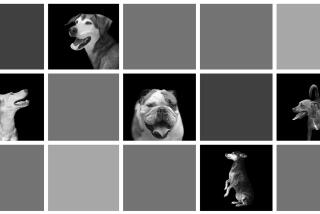Bane and Hera Were Simply the Instruments of Death
One defendant has been put to death. The other is penned in protective custody, awaiting this week’s court hearing to decide her fate.
But the real culprits in the fatal mauling of a San Francisco woman are still roaming free, holding press conferences, writing angry letters, going on talk shows . . . blaming Diane Whipple’s death on everything but their own failings.
The animals have taken center stage in this tragedy--Bane and Hera, two giant dogs, bred for power and ferocity, who killed Whipple as she stood at her apartment door with her groceries. In judgment, we vent at the extremes. We pity or fear them; see these pets as hapless victims, or advocate the extermination of every dog like them.
But dogs are only . . . well, dogs. Instruments of death, sometimes, but never masterminds. They are simple creatures with basic needs, who act as their nature and upbringing decree. They depend on us to set their boundaries.
“It’s like a 6-year-old who finds a gun in his house and kills a playmate,” says West Los Angeles animal trainer Michael Chill. “Do you blame the child, or do you blame the parents for not keeping that gun out of reach?”
Aggression in dogs can be subdued by love and nurturing. But only constant vigilance can ensure that these loaded guns don’t hurt someone.
“It’s up to the owners to learn to read the subtle signs [of aggression] and to exercise enough control to keep these dogs out of dangerous situations,” Chill says. “Whether the owners of Bane and Hera were actually horrible people, simply naive about the potential for danger or overconfident in their ability to handle these two dogs . . . they’re ultimately responsible for the damage done.”
*
Owners Robert Noel and Marjorie Knoller say Bane and Hera were beautiful and gentle. Who am I to say that wasn’t true, at least some of the time? I spent years in love with a canine outlaw, a mix of two of the world’s most dangerous breeds.
She joined our family unexpectedly, bought on impulse from a neighborhood pet store. She was the result of an unplanned rendezvous between the store owner’s pet Rottweiler and a pit bull owned by a family down the street.
Her 12 littermates had all been sold. Cookie was the runt--a tiny, brown fur ball with big feet and eyes that glittered like gold. “She’d make you a great pet,” the owner told me. Or she’d make someone a great fighting dog, I thought. I scooped her up and took her home.
My children were delighted; my friends thought I had lost my mind. I wondered what kind of menace I’d rescued as I watched her, all of 10 weeks old, dominate our headstrong 2-year-old dog.
I read all I could about training puppies to thwart aggression, about family-as-pack and Alpha dogs. I tested and taught her . . . took her bowl away mid-meal to see if she’d growl, pried toys from her strong jaws to teach her to yield. She never snarled or growled, never showed us anything but affection and love.
Then came the day she bit a friend’s puppy who was only trying to play. Her teeth left a bloody gash in his head. Then, she growled at a friend of my daughter’s, as the two girls roughhoused on the lawn. There was the standoff at the dog park with a German shepherd, then the attack on our neighbor’s Chihuahua, who had ventured into our garage and charged at Cookie, yapping loudly but harmlessly.
I considered myself warned. No more trips to the dog park, walks off leash, play dates with unfamiliar children or dogs. She still slept on my bed and frolicked with the kids, who played dress-up with her, sat astride her like a pony, used her as a pillow while they watched TV.
She was still our sweet and gentle Cookie, but she could no longer be counted upon to contain the snarling beast within. We kept a tight rein on her until her death three years later.
*
In San Francisco, prosecutors have compared this case to a runaway car that kills someone. If it can be shown that Noel and Knoller knew their dogs were dangerous, they could be charged in Whipple’s death. Conviction of a felony could net them four years in prison and a $10,000 fine.
The case has been full of twists and turns, including allegations that the dogs were part of a fighting-dog breeding operation run by imprisoned white supremacists who were clients of attorneys Knoller and Noel.
Then there are the ugly accusations that the couple has made: that Whipple may have incited the dogs by wearing perfume or using steroids, that she didn’t get into her apartment fast enough after Bane first lunged at her. They’ve blamed paramedics for not tending her quickly enough. They’ve even blamed Hera, whose barking may have spurred Bane on.
But none of that really matters. Diane Whipple is not dead because of breeding rings or perfume or paramedic ineptitude. She died because two people--out of ignorance or arrogance--failed to take precautions to protect an innocent bystander from their dogs.
There will always be someone wearing perfume, dogs who bark at one another, neighbors passing by in the same hall. They are not the problems. In the hallway that day, Knoller mishandled her loaded weapon. And Whipple--and Bane and Hera--shouldn’t be the only ones to pay.
More to Read
Sign up for Essential California
The most important California stories and recommendations in your inbox every morning.
You may occasionally receive promotional content from the Los Angeles Times.









